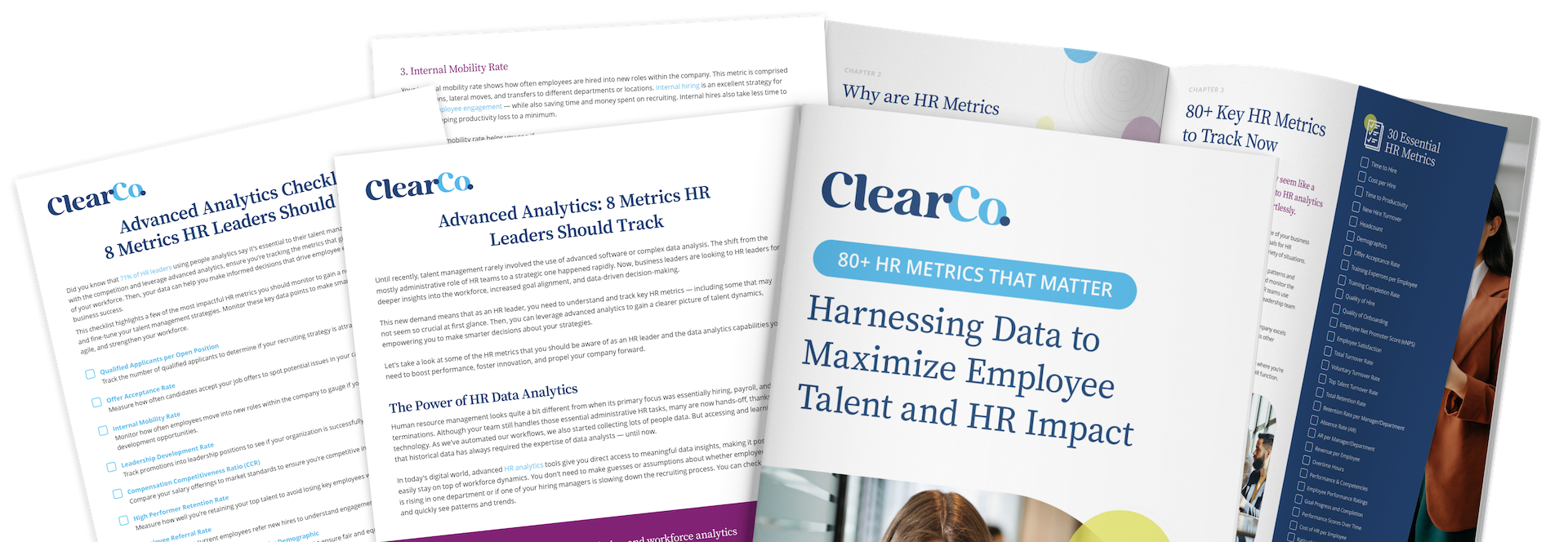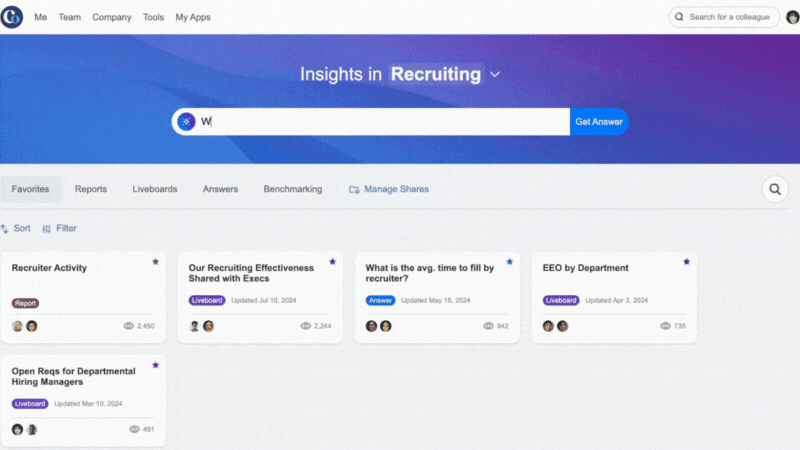Talent acquisition teams are itching for data they can actually use to improve their recruiting process. 61% of organizations said that providing useful people data and analytics is the top priority for their HR technology. But only 33% said their analytics are producing actionable insights. But why?
According to 81% of respondents, disjointed HR systems are holding their team back from achieving important goals. Long story short, their historical data is too disconnected to tell a clear story. You need reliable data, powerful software, and a team prepared to leverage it for a data-driven recruiting process.
What Is Data-Driven Recruiting?
Recruiting teams have been using technology to make hiring tasks easier for decades. Those systems helped them manage applications and candidate details. But without an HR data analyst, companies couldn’t learn anything from that data. Improving recruitment strategies mostly came down to trial and error.
Today, recruiting software, like applicant tracking systems (ATS), is much more robust. It doesn’t just collect information on your candidates — it analyzes the data, giving you deeper insights you can use to speed up hiring and make better hiring decisions.
What really sets data-driven HR and recruiting apart is how teams use analytics to guide every part of hiring — not just the decision at the end. While only about 42% of organizations say their people data is super accurate, there’s a clear shift toward making that data better and more useful. And with 57% of HR pros expecting their tech investments to boost both the employee experience and HR’s own productivity, the momentum is building.
When you go all-in on data-driven recruiting, you can:
- Find out which sourcing channels actually deliver top candidates, so you’re not wasting time or budget
- See exactly where your hiring process slows down (and fix it for next time)
- Track important DEIB metrics and move the needle on your company’s goals
- Compare your hiring numbers with what’s happening elsewhere in the industry
- Make hiring calls that are consistent and less biased, every time
As more companies focus on actionable insights, data-driven recruiting is quickly becoming standard practice.
5 Benefits of Data-Driven Recruitment Strategies
So, what are the benefits of using talent analytics and leaning into a data-driven recruitment approach? Here’s how the numbers stack up:
1. Improved Quality of Hire
AI and analytics are taking the guesswork out of hiring and helping teams improve their quality of hire. Nearly half of HR professionals now see AI as a critical part of the future of talent acquisition. With smarter tools, teams can not only write more consistent, accurate job descriptions. They’re also able to spot skills gaps faster, identify high-potential candidates, and even reallocate internal talent.
Strategic data use equips your team to make better hires across the board — and boost employee engagement at the same time.
2. Reduced Time-to-Hire
Time-to-hire and time-to-fill are important metrics for recruiting teams, especially as longer hiring processes have become the norm. Candidates report spending months in hiring funnels and going through as many as eight interviews before getting hired — or not. But faster hiring isn’t a pipe dream with AI.
77% of organizations expect AI to seriously increase HR productivity, and 71% say automation will help speed up time-consuming tasks. More efficient workflows mean fewer drop-offs and smoother experiences for both recruiters and candidates.
3. Lower Cost-per-Hire
Reducing costs is a constant goal for most teams, and analytics can quickly help you reach it. AI analytics show you what’s working and what’s not in your candidate sourcing strategy. Which sources of hire are bringing in top candidates, and which are just costing you money?
Optimizing your process and moving spend away from channels that aren’t delivering can help rein in recruiting costs over time.
4. Better Candidate Experience
The push for a stronger candidate and employee experience is only growing. Candidate resentment — the percentage of candidates across job types and demographics who said they would never apply again, refer others, be a brand advocate, or a customer — is at 14%, the highest it’s ever been. That’s costing organizations great employees and hurting their employer brand.
Your talent data is essential for improving the candidate and employee experience — 57% said their HR tech has helped them make measurable improvements. But only one-third of HR teams are getting the most from their software solutions. Focusing on data means you can personalize communication, streamline the journey, and keep candidates engaged from first click to final offer.
5. Reduced Bias in Hiring Decisions
When you implement a data-driven recruiting strategy, your technology helps highlight inconsistencies and encourage objectivity. Upskilling in people analytics and investing in AI — like 60% of HR teams are doing now — gives your team the ability to spot patterns, monitor outcomes, and ensure fair evaluations for every candidate.
To sum up the benefits, shifting to data-driven recruitment pays off. Organizations betting on analytics and better tech see real gains across hiring quality, speed, candidate experience, and more.
5 Best Practices for Implementing Data-Driven Hiring
Ready to make data a bigger part of your hiring playbook? Here are some best practices to help you shift from guesswork to strategy and get real results.
1. Define Clear Hiring Goals
If you were pursuing a college degree, what would you picture as the end result? You’re probably imagining yourself on stage at graduation or earning a promotion with your new skills. You probably wouldn’t envision flunking a class or dropping out — that wouldn’t motivate you to stay on track; completing your assignments and going to class.
The most successful endeavors begin with picturing what success looks like. What does hiring success look like for your team? Is it better retention, a stronger pipeline for hard-to-fill roles, or something else entirely?
Aligning your hiring objectives with broader business goals is key. 47% of organizations see process optimization as a top area for growth.
2. Identify Key Metrics & KPIs
Focus on key hiring performance metrics that actually move the needle. Only 33% of organizations say their HR analytics are highly actionable, so zero in on must-have metrics like quality of hire, candidate source effectiveness, and job offer acceptance rates. Clear, useful KPIs keep everyone aligned and focused.
3. Use the Right Technology
If you’re not measuring recruiting data, you can’t track progress toward talent acquisition initiatives. Most companies use multiple HR tech solutions, but just 39% say their systems actually work well together. Invest in tools that capture clean data and integrate well with each other, whether it’s an ATS with built-in talent analytics, an interview scheduling platform, or an onboarding app.
If you’re using a complete talent management system comes in. This system connects every part of the talent lifecycle — like sourcing, hiring, onboarding, L&D, and performance management — to eliminate data silos and create seamless workflows.
A unified platform offers benefits like:
- Streamlined hiring workflows: Automate tasks like interview scheduling and background checks to save time and reduce errors.
- Smarter decision-making: Use built-in analytics to identify top candidates, track hiring metrics, and benchmark performance.
- Improved candidate experience: From AI-enabled personalized communication to mobile-friendly onboarding, a connected system keeps candidates engaged at every step.
Investing in the right technology to improve recruiting efficiency and build a recruiting process that’s smarter, faster, and contributes to business success.
4. Apply Insights To Improve Hiring Processes
Data is only useful if you use it. Review your dashboards regularly, share insights with hiring managers, and try low-risk experiments. Half of organizations are focusing on user training to better leverage their HR tech, so don’t just look at the reports — act on them.
5. Ensure Compliance & Privacy
Handling sensitive data comes with great responsibility. As you gather and use more candidate information, double-check your processes for security, fairness, and regulatory compliance. About 25% of HR professionals flagged privacy as a key concern for AI adoption, making it essential to get buy-in from both legal and leadership teams.
When you dial in these best practices, you’re making smarter, more confident hiring decisions that move your business forward, one data point at a time.
Hire Smarter With ClearInsights AI-Powered Analytics
Hiring shouldn’t be guesswork. A data-driven approach helps recruiting teams make smarter decisions, improve candidate experiences, and move the needle on real business goals. Stop relying on spreadsheets and slow manual reporting. Switch to a complete talent management system, and give your team real-time insights, faster workflows, and measurable results at every step.
Ready to see how ClearInsights analytics can take the pain out of hiring data? Schedule a demo with a ClearCompany expert and start building a recruitment strategy that’s fast, fair, and focused on quality hires.



